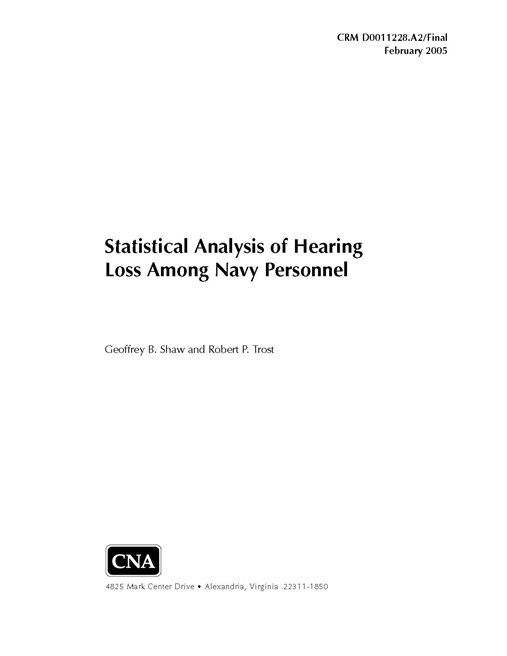Permanent hearing loss is one of the most common disabilities among sailors. Although noise-induced injury is preventable by limit- ing exposure, it is generally irreversible once it occurs. In 2004 the Veterans Administration (VA) spent $108 Million dollars in disability payments to 15.8 thousand former Navy personnel for hearing loss. This represents an increase of $65 Million in spending by the VA on Navy hearing disability payments since 1999. The focus of this study is to find out how hearing loss relates to service time spent aboard ships, in order to reduce disabilities and costs.
Over a career in the US Navy, Service Members characteristically are posted to a variety of stations, both afloat and ashore. Many of these posts have high noise levels, such as certain ships; and particular rat- ings have high exposure, such as jobs near machinery. If assignments of higher risk both in location and tasking can be identified, then focused prevention programs can be implemented, such as closer monitoring of all personnel, preventive measures in key high risk locations and ratings, focused noise control in ship design, and per- haps better rotational schedules. All these preventative methods may reduce damage to the hearing of Navy personnel. This will preserve quality of life for personnel, and save millions of dollars for government.
In order to investigate which duty stations and ratings are at a high risk for hearing loss, this study looked at the Defense Occupational and Environmental Health Readiness System (DOEHRS) medical hearing test records of nearly 251,000 enlisted sailors and officers over the twenty-five year period 1979 to 2004. The study found that enlisted sailors who spend most of a 24 year Navy career assigned to a Naval Surface Warship1 as opposed to being assigned to ashore duty stations or a Naval Support ship, had a much higher probability of leaving the Service with a reduction in their ability to hear.
Since many individuals lose some hearing as they age, the study con- trolled for aging along with other factors such as gender and race to properly test if there are differences associated with ship assignments. To accomplish this task, we merged Navy medical records of hearing tests with information on each individual sailor's duty stations.
To give a sense of the magnitude of hearing loss from time spent aboard certain types of ships, we considered a 24-year career. For an enlistee, the probability of a potential hearing loss in a 24-year career if most of that time was spent on a surface warship, is 46 percent. If that same sailor spent the 24-year career ashore, the probability would be 27 percent. This 19-percentage point difference is signifi- cant both practically and statistically speaking. This study is the first to identify the magnitude of the problem after controlling for aging and other factors.
Download reportCleared for Public Release; Distribution Unlimited. Specific authority: N00014-00-D-0700.
Details
- Pages: 48
- Document Number: CRM D0011228.A2/Final
- Publication Date: 2/1/2005
